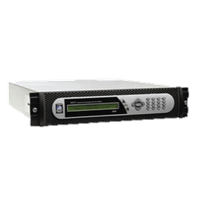 D9054 HDTV Encoder
D9054 HDTV Encoder
The MPEG-4* part 10 (H.264/AVC) Encoder Model D9054 is the right choice for any operator who wants to compress high-definition video using MPEG-4 compression technology. PreSightPlusTM pre-analysis, dual-pass technology and single-slice architecture efficiently utilizes the scarce bandwidth resources in distribution systems and provides excellent picture quality. Supporting both 1080i and 720p, the encoder offers AVC encoding in various distribution and contribution applications. Based on a dedicated encoder resource, the D9054 Encoder optionally supports picture-in-picture (PIP) functionality for convenient channel change and mosaic applications. The HDTV Encoder will support multiple audio formats, providing excellent flexibility. It will support up to two stereo pairs of either MPEG-1 Layer II audio, Dolby® Digital (AC-3) 2.0 audio, AAC audio, or AACv1 audio with a broad range of bit rates, and will support pass-through of externally encoded Dolby 5.1 audio.
 9825M and 9825S Modulators
9825M and 9825S Modulators
The Models 9825M and 9825S Modulators and Model 9815 Rear Interface Module (RIM) are Scientific-Atlanta’s latest additions to our well-known product family of Continuum Headend Systems. The Continuum Headend System product family provides users with a vertically oriented, compact, full-featured ensemble of headend functions. Continuum products give today’s video information providers an integrated, high-performance platform for many vital headend applications.
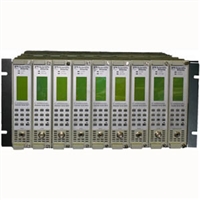 Continuum Headend System
Continuum Headend System
The Continuum Headend System product family provides users with a vertically-oriented, compact, full featured ensemble of headend functions. The Model 9811 and 9814 Controllers manage all activities between application modules in addition to supporting external monitoring and control.
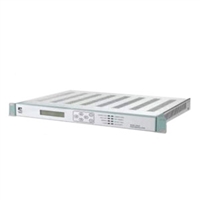 Continuum DVP Models D6238 and D6239 8VSB Demodulator
Continuum DVP Models D6238 and D6239 8VSB Demodulator
The Continuum DVP Models D6238 and D6239 8VSB Demodulators from Scientific-Atlanta, enable 8VSB television signals to be inserted into digital cable systems. Both the Model D6238 and Model D6239 will process an off-air HDTV 8VSB television signal providing an ASI output for injection into a QAM modulator. The Model D6239 also includes a built-in multiplexer allowing for the combining of two 8VSB broadcast signals into a single 38 Mbps ASI output for use in 256 QAM cable applications.
Using a standard web browser via the RJ-45 Ethernet port, you can set up all parameters in just a few minutes. Parameters include local station selection, alarms, and even PSIP processing.
You can select certain program elements contained in the stream for deletion. For example, if you choose to completely delete private data services from a particular stream you can simultaneously modify channel numbers to allow correct channel mapping. In another example if both HDTV and SDTV signals are present in the stream, you can just pass the signal you want to inject into your cable system.
Both the Model D6238 and Model D6239 provide quality monitoring of carrier, and transport stream via web interface. Warning and major alarm signals are also provided via contact closures. Plus, the Model D6239 includes switching to a local alternate ASI program.
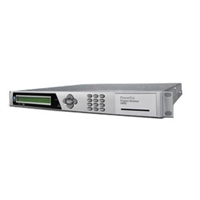 PowerVu® Model D9850
PowerVu® Model D9850
The PowerVu® Model D9850 Program Receiver is designed for satellite content distribution applications requiring 4:2:0 video decoding. The receiver offers the capability to receive digitally encrypted video, audio, utility data, and Vertical Blanking Interval (VBI) data.
Analog Cable Program Distribution
Composite video and balanced audio outputs can be connected to analog modulators for analog cable distribution. Four mono audio channels or two stereo pairs are available for primary audio programs and/or secondary audio programs (SAP). For example, primary program audio could be carried on one of the stereo pairs, while SAP audio is carried on the other stereo pair.
Digital Cable Program Distribution
An uplink-addressable transport output provides MPEG program streams for digital tier program delivery. This ensures that the highest quality video programs are efficiently distributed to households equipped with digital set-top boxes.
Digital Program Replacement
Digital program replacement (DPR) allows a programmer to seamlessly switch their primary service to an alternate service in the digital domain in blackout applications for cable digital tier distribution. This feature remaps the PID information from the primary service to an alternate service allowing downstream devices to continue to operate seamlessly. This ensures availability of alternate programming in the digital tier without operator intervention.
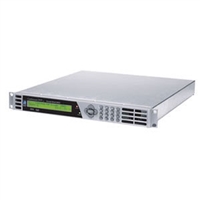 D9032 Encoder
D9032 Encoder
In the broadcast and broadband world, optimizing bandwidth in your distribution channels is of utmost importance. The Model D9032 Encoder is designed to deliver high-quality MPEG-2 video while using very limited bandwidth. Used in either constant or variable bit rate or in a closed loop statistical multiplex mode, the encoder delivers clean and sharp pictures.
The D9032 Encoder includes PreSightPlus™ technology - a unique new DSP-based pre-processing architecture that carries out multiple pre-processing steps to help optimize the encoding process. PreSightPlus algorithms perform three functions addressing different issues in a compression system:
- Adaptive and motion compensated noise reduction
- Auto-concatenation enabling the encoder to lock the encoding GOP to that of the preceding encoder
- Pre-analysis for optimal dual pass encoding
PreSightPlus Pre-analysis combined with the Regulus™ Statistical Multiplexing Controller is an industry leading solution for bandwidth-saving encoding using closed loop statistical multiplexing technology including dual statmux pool support. The dual pass architecture of the encoder provides detailed information to the statistical multiplex controller, allowing it to make better bit rate allocation decisions.
Control of the encoder is supported via a front panel interface, an on-board web application, an optional ROSA™ driver, and an open communication protocol (SNMP). Transport output is provided via ASI outputs as well as through an IP (100Base-T) streaming output.
The extensive features allow the D9032 Encoder to address a wide range of applications such as contribution, cable headends, DTH or DVB-T play-outs and IP headends.
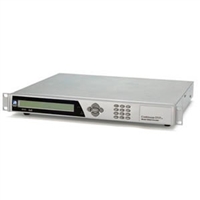 Continuum DVP™ Model D9020 Encoder
Continuum DVP™ Model D9020 Encoder
The Continuum DVP™ Model D9020 Encoder offers a cost-effective, compact solution allowing Headend operators to convert NTSC/PAL programs into compressed MPEG-2 format. Requiring only 1RU of space, the encoder offers two stereo pairs of audio (including SAP), analog and SDI video inputs, and dual DVB-ASI transport outputs. Closed-captioning, V-Chip and DVB WST are supported. For ease of use, the encoder supports stand-alone operation with an intuitive front panel control. With on-board web page generation, the encoder is easily controlled and monitored via an Ethernet connection and a Web Browser. For applications requiring a full network interface, SNMP v2 with a simple MIB is supported.
Local Encoding Applications
- Encode local programs for use on the digital tier
- Encode programs for the digital tier after locally inserted analog advertising
Bandwidth Recovery Applications
- Recover transport bandwidth between Headend hubs by transmitting multiple compressed programs per OC- 3 link in digital transport applications
- Recover bandwidth to add new services such as HDTV or VOD/SVOD by easily moving analog programs to the digital tier
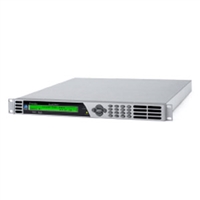 Model D9022 Encoder
Model D9022 Encoder
The Model D9022 Encoder is designed to deliver high-quality SD MPEG-2 video. The encoder supports two IP outputs and 3 ASI outputs simultaneously.
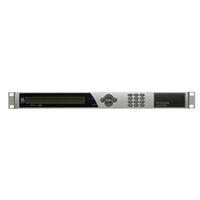 Model D9050 MPEG-2 HD Encoder
Model D9050 MPEG-2 HD Encoder
The newest generation MPEG-2 HD encoder provides multiple benefits in multi-channel encoding systems for HD/HD or HD/SD statistical multiplexing. This high-performance, cost-efficient encoder includes our newly developed content-aware compression algorithm and PreSightPlus dual pass architecture for excellent video quality regardless of content complexity.
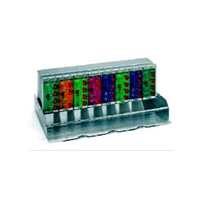 Series 9900 RF Signal Manager
Series 9900 RF Signal Manager
Combining and splitting architectures are becoming far too complex to rely on passive product alone to accomplish the isolation and amplification requirements to support the advanced HFC network designs for new targeted and narrowcast services. The new family of Series 9900 RF Signal Manager introduces a family of special purpose amplifiers that fill a missing niche in today’s isolation and amplification requirements.
The RF Signal Manager Active family is a low-cost, high-quality solution to isolation and gain requirements for new design HFC networks. The active products mount easily in the RF Signal Manager chassis, so platform advantages such as mounting density and cable management are retained.
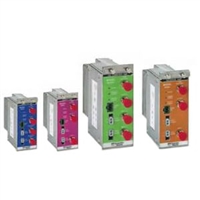 Series 9900 RF Signal Manager Modules
Series 9900 RF Signal Manager Modules
Advanced HFC networks now include numerous 2-way interactive services that offer significant new sources of revenue for the system operator. These networks have changed the requirements for headend/hub RF combining and splitting networks. New services coupled with fewer homes passed per fiber node require a completely engineered method of RF signal routing and interconnection at the headends and hubs where the services originate.
The Scientific-Atlanta Series 9900 RF Signal Manager is a family of products designed to simplify the complex RF networks that support these key services in HFC system headends and hubs. A complete family of passive signal splitting and combining modules support both forward (50-1000 MHz) and reverse (5-70 MHz) path applications.
The Series 9900 RF Signal Manager is a modular system that provides completely symmetrical splitter/combiner and directional coupler components that mount easily in a multifunction chassis. Each forward or reverse module is available in 2, 4, and 8-way versions. Directional couplers (10 dB and 20 dB) are also available to provide low loss signal sampling or test point access anywhere in the network. Each module offers superior electrical specifications compared to taps or generic headends and hubs where the services splitter/combiner components and is packaged to ensure outstanding RF integrity. The Series 9900 RF Signal Manager module packaging allows for maximum product density without exceeding normal practices for accessibility and maintenance. The 4-way and 8-way versions utilize plug-in attenuator pads for enhanced signal balancing and matching requirements.
In addition to the modules themselves, the Series 9900 RF Signal Manager system provides a chassis/rack mounting system that fits the architecture of typical CATV headends and hubs. This system provides easy access to each module as well as methods of identifying its dedicated use in the network. Emphasis has been placed on the ability to build flexible networks with ease of maintenance and accessibility to the modules and interconnecting cables.
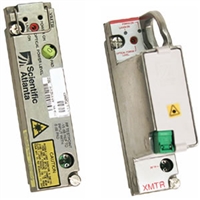 Analog Reverse Optical Transmitters with Thermal Compensation
Analog Reverse Optical Transmitters with Thermal Compensation
The Models 6940, 6942, 6944, GainMaker® and GS7000 Nodes may be equipped with 1310 nm or Coarse Wave division Multiplexing (CWDM) analog reverse optical transmitters to facilitate reverse communications from node to headend or hub site. These reverse optical transmitters are now thermally compensated for improved performance over temperature.
The CWDM reverse optical transmitter is offered in a choice of 8 wavelengths from 1470 to 1610 nm. Up to 8 CWDM reverse optical transmitters can share a common return fiber when used with accompanying multiplexing and demultiplexing passive optics.
All of these reverse optical transmitters incorporate distributed feedback (DFB) lasers, which are best suited for high-capacity reverse traffic. They are available in both standard and high gain versions, in order to allow flexibility in reverse path design. The high gain versions are typically used in the Model 6944, 6942, and GS7000 segmentable nodes. The standard gain versions are typically used in the Model 6940 and GainMaker nodes. All optical transmitters used in the GS7000 Node have a new high profile module cover that includes both a self-contained fiber pigtail storage area and an integrated pull ring for easier module installation and removal.
The reverse optical transmitters specified in this data sheet include both a Power On LED and an Optical Power Alert LED, enabling quick visual confirmation of operational status. A DC test point that is scaled to the optical output power is also included.
Optionally, to help ensure maximum reliability and quick fault resolution, the reverse transmitters can be remotely monitored using the Scientific-Atlanta Transmission Network Control System (TNCS).
 1310nm, 1550nm and CWDM Analog Reverse Transmitters
1310nm, 1550nm and CWDM Analog Reverse Transmitters
The Models 6940, 6942, 6944, and GainMaker® Optoelectronic Receiver Stations (nodes) may be equipped with 1310 nm, 1550 nm, or CWDM (or any combination) analog reverse optical transmitters to facilitate reverse communications from node to headend or hub site.
There are two types of lasers used in the 1310 nm reverse optical transmitters. The distributed feedback (DFB) type is best suited for high-capacity reverse traffic, and can accommodate analog video carrier transmission. The Fabry-Perot (FP) type is lower priced and designed for data carrier transmission applications with less stringent performance requirements.
The 1550 nm reverse optical transmitter uses a DFB laser well suited for high-capacity reverse traffic, and canaccommodate analog video carrier transmission.
The CWDM reverse optical transmitter is offered in a choice of 8 wavelengths from 1470 to 1610 nm. Up to 8 CWDM reverse optical transmitters can share a common return fiber when used with accompanying combining and splitting passive optics. The CWDM reverse optical transmitters use a DFB laser and are well suited for high capacity reverse traffic.
All of these reverse optical transmitters are available in standard and high gain versions, in order to allow flexibility in reverse path design. The high gain versions are typically used in the Model 6944 and Model 6942 segmentable nodes. The standard gain versions are typically used in the Model 6940 and GainMaker node.
A variety of transmitter configurations may be utilized in Scientific-Atlanta® nodes. In the Model 6944 node, four reverse transmitters are used for full four-way (quad) reverse segmentation, with a separate transmitter dedicated to each of the station’s four reverse RF input ports. For two-way (dual) reverse segmentation, two transmitters are used, one for each combined pair of RF input ports. In the Model 6940, 6942 and 6944 nodes, for standard operation (no reverse segmentation) the stations may be configured with either a primary transmitter only, or with both a primary and redundant transmitter. The GainMaker node supports one transmitter.
The reverse optical transmitters specified in this data sheet include both a Power On LED and an Optical Power Alert LED, enabling quick visual confirmation of operational status. A DC test point that is scaled to the optical output power is also included.
Optionally, to ensure maximum reliability and quick fault resolution, the reverse transmitters can be remotely monitored using the Scientific-Atlanta Transmission Network Control System (TNCS).
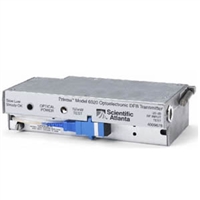 Prisma 1310nm DFB Reverse Transmitter for 6920 node
Prisma 1310nm DFB Reverse Transmitter for 6920 node
The reverse transmitter of the Model 6920 Node facilitates the reverse connection from node to headend or hub site. The Prisma® 1310 nm distributed feedback (DFB) reverse transmitter is best suited for high-capacity reverse traffic and can
accommodate analog video carrier transmission. These transmitters include a Power On LED and an Optical Power Alert LED, enabling quick visual confirmation of operation status. A DC test point that is scaled to the optical power (1V = 1mW) is also included. Also, the upstream can be monitored by using the Status Monitor connection.